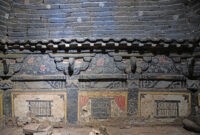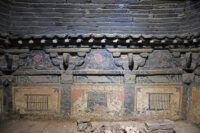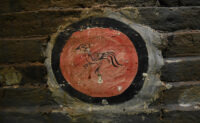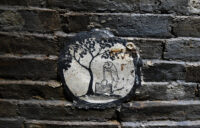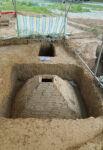 Archaeologists have discovered brick chamber tombs decorated with rich murals dating to the Ming Dynasty (1368-1644) in the city of Changzhi, Shanxi Province, northern China. Three tombs believed to be family tombs from the early Ming Dynasty were found. Two of the them are intact. The roof of the third, a rectangular brick tomb with a vaulted ceiling, has collapsed, damaging the walls and contents, but the remains of a mural are still visible.
Archaeologists have discovered brick chamber tombs decorated with rich murals dating to the Ming Dynasty (1368-1644) in the city of Changzhi, Shanxi Province, northern China. Three tombs believed to be family tombs from the early Ming Dynasty were found. Two of the them are intact. The roof of the third, a rectangular brick tomb with a vaulted ceiling, has collapsed, damaging the walls and contents, but the remains of a mural are still visible.
The Shanxi Provincial Institute of Archaeology began excavating the site last year in advance of road construction. They encountered a tomb on the southeast, one on the north and one of the southwest of the site. The rectangular tomb with the collapsed ceiling was the southeastern one. The other two are brick with pyramidal roofs. They are in good condition, with the murals — very similar in style and subject — still in vivid color.
 The murals depict religious motifs and scenes from daily life, reflecting the idea that people would live much the same lives after death as they had before. The central burial chambers are painted with florals and faux architectural features including wooden doors, lattice windows, pillars, eaves and rafters that mimic the style of a residence from the period.
The murals depict religious motifs and scenes from daily life, reflecting the idea that people would live much the same lives after death as they had before. The central burial chambers are painted with florals and faux architectural features including wooden doors, lattice windows, pillars, eaves and rafters that mimic the style of a residence from the period.
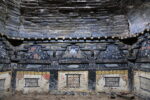 The murals also include celestial imagery. There’s a star on the roof. On the eastern wall is a red disc with a bird in the center that represents the sun and the mythological crow or phoenix associated with the sun. On the opposite wall is the moon, a white disc on which the mythological Jade Rabbit stands under a tree, constantly pounding the elixir of life.
The murals also include celestial imagery. There’s a star on the roof. On the eastern wall is a red disc with a bird in the center that represents the sun and the mythological crow or phoenix associated with the sun. On the opposite wall is the moon, a white disc on which the mythological Jade Rabbit stands under a tree, constantly pounding the elixir of life.
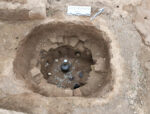 A brick octagonal structure discovered in the excavation appears to have had some ritual function connected to the tombs. It is five feet in diameter and has six niches on its interior walls where statuettes and other objects were placed. The excavation unearthed 18 objects including large ceramics, bronze coins and bronze mirrors.
A brick octagonal structure discovered in the excavation appears to have had some ritual function connected to the tombs. It is five feet in diameter and has six niches on its interior walls where statuettes and other objects were placed. The excavation unearthed 18 objects including large ceramics, bronze coins and bronze mirrors.
